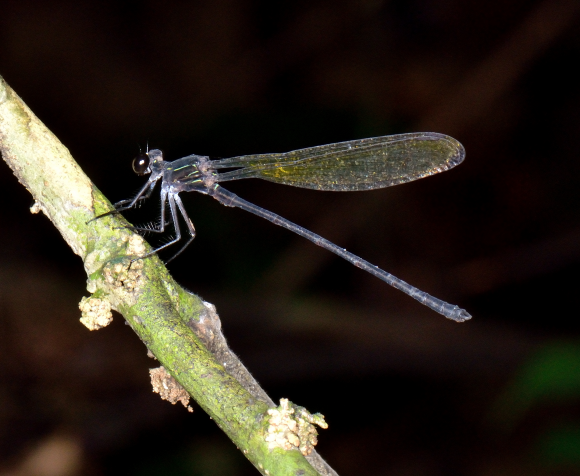Genus Pentaphlebia Förster, 1909
relics
Type species: Pentaphlebia stahli Förster, 1909
Introduction
The genus was long known only from P. stahli from western Cameroon and P. gamblesi, collected just once on the Obudu Plateau in adjacent south-eastern Nigeria, but P. mangana was recently discovered in north-western and southern Gabon and western Congo-Brazzaville. These damselflies are unique in Africa by the combination of their large size (hindwing 31-37 mm) and long and narrow wings. These are often smoky or yellow-stained and have four to six antenodal cross-veins, over 30 postnodal cross-veins but no cross-veins in the quadrilateral cells, darkened falcate tips, and very long pterostigmas. Adult males are rather dark and plain, with reddish to black thorax and abdomen. They perch inactively close to rapids and cascades in rocky rainforest streams, often in deep shade. [Adapted from Dijkstra & Clausnitzer 2014]
Diagnosis
The only genus currently recognised in this family. Please refer to the family diagnosis and introduction for more information.

Pentaphlebia mangana Dijkstra, Lambret & Mézière, 2015. Male © Nicolas Meziere
Map citation: Clausnitzer, V., K.-D.B. Dijkstra, R. Koch, J.-P. Boudot, W.R.T. Darwall, J. Kipping, B. Samraoui, M.J. Samways, J.P. Simaika & F. Suhling, 2012. Focus on African Freshwaters: hotspots of dragonfly diversity and conservation concern. Frontiers in Ecology and the Environment 10: 129-134.
References
- Asahina, S. (1956). Notes on an African amphipterygid, Pentaphlebia stahli Foerster (Odonata: Amphipterygidae). Kontyû, 24, 221-223.
- Parr, M.J. (1977). A second species of Pentaphlebia Foerster (Zygoptera: Amphipterygidae), from the Nigerian-Cameroun border. Odonatologica, 6, 77-82. [PDF file]
Citation: Dijkstra, K.-D.B (editor). African Dragonflies and Damselflies Online. http://addo.adu.org.za/ [2024-07-27].

